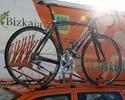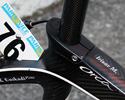
Recently on Cyclingnews.com |
Tech Feature: 2009 Orbea Orca launch, March 24, 2008
Having a whale of a time on Orbeaís new Orca
By Ellis Bacon

|
Orbeaís Orca frame caused more than a few ripples of excitement when it was launched in summer 2006. After all, here was a frame with the stiff, fast and light ride of a Formula One car plus the eye-catching good looks to match.
Even with the current modelís continuing success, the Basque framebuilders have turned things up another notch with a rather early introduction of the 2009 Orca - available now - which Orbea claims is a substantial 20 percent stiffer and, by losing nearly 90 grams, also 10 percent lighter. Claimed weight is now just 1290g for the frame, fork and headset yet prices will reportedly increase only marginally over current figures.
"We listened to both the team and to the market, and tried to put those needs into this frame," explained Orbea marketing manager Joseba Arizaga. "After feedback from the Euskaltel riders, we made some not radical, but important, developments."
"The Orca is an Ďaliveí project. Itís always moving," explained Miriam Bengoetxea - an experienced composites engineer and Orbeaís product development manager. "We know that the pros are always pushing things to the limit, so we have consulted them a great deal. This evolution takes things to the next level."

|
Orbea retained the existing mould and thus the current Orcaís sensual lines. Improvements were primarily made by fine-tuning the carbon lay-up schedule as well as the mix of high modulus Toray M40J and high-strength M30S fibres that was used. Previous Orcas used a 50/50 mix of M40J and M30S; the 2009 model now uses a stiffer 70/30 blend.
"It would be easy to simply make a frame lighter: you just take out 10 or 20 layers carbon," added Bengoetxea. "Of course, in reality, itís not that simple, as durability would be compromised. Equally, itís easy to make a stiffer frame: just use more M40J carbon. But then strength is compromised. It could be damaged if you hit a pothole, for example. You need a mix to make the frame stiff, light and durable."
"Even better carbon fibre is available," Bengoetxea admits. "But we can only use the best that is available to us, as it is not all available for use in the bike industry, as lots are used by, for example, Airbus. Our goal was to get ultimate efficiency."

|
The new carbon mix yields the desired increase in stiffness in the carbon structure itself but the weight savings came elsewhere. The beautifully designed seat clamp of the previous Orca is now magnesium instead of aluminium and the head tube badge with its cleverly integrated housing stops is now carbon fibre. The material changes yield 20g and 7g of savings, respectively, and new one-piece alloy dropouts shave another 25g.
"Some manufacturers use carbon drop-outs," says Bengoetxea, "but if you crash, you canít replace them, and your bike is finished."
Other weight saving details include a carbon fibre seat tube insert instead of previously used aluminium, a new front derailleur mount and even the more spartan finish.
"The weight savings of each piece donít sound that much on their own, but already we were on the limit, so 10g here and 10g there is a big percentage," added Arizaga. "To reduce the seat clamp - such a small piece - by 20g is, we think, pretty incredible. Some push their weight, some push their stiffness. But we do both, and with a lifetime warranty to go with it, too."

|
Letís make no bones about it; the Ďoldí Orca was, and still is, a notable performer among its peers. Having rigorously tested the previous version - and having been extremely satisfied - a fair bit of work was needed to improve on it. Nevertheless, the significant increase in stiffness was noticeable on our preliminary test rides yet still remaining was the same comfortable ride, light and manoeuvrable handling, and reassuring high-speed stability we were accustomed to.
Orbeaís Euskaltel-Euskadi team is apparently pleased with the changes, too, as it has been putting the new frame through its paces at least since last yearís Tour de France. With months of pro-level testing under its belt and what sounds to be carefully chosen evolutionary changes, the new Orca is likely to be a winner indeed.
Photography
For a thumbnail gallery of these images, click here
Images by Ellis Bacon/Procycling
- Orbea has launched a new version of its well-received Orca that is both stiffer and lighter than before.
- The new Orca bears the same lines as the original but a more finely tuned fibre blend and lay-up schedule means the improvements are hidden within.
- Gone is the gloss finish in favour of a more subdued matte clearcoat and understated white accents.
- Orbea designers shaved a lot of weight merely by swapping the seat clamp's aluminium construction in favour of magnesium.
- The new one-piece dropouts are lighter but also stiffer and and also retain the replaceable hanger.
- A carbon fibre head tube badge retains the clever integrated housing stops.
- Euskaltel-Euskadi team mechanics load up the bikes for a ride.
- To be a pro is to ride a clean bike!
- There's nothing like a good long climb to get a feel for a new bike.
- Orbea product development manager Miriam Bengoetxea stands proudly with her new creation.
Images by James Huang/Cyclingnews.com
- The 2009 Orca is new to consumers but Euskaltel-Euskadi riders have been testing it at least since last year's Tour de France as seen here.
- Even items such as the carbon head tube badge have been in test for months now.
- Likewise, the one-piece dropouts have seen plenty of action on team prototypes.

